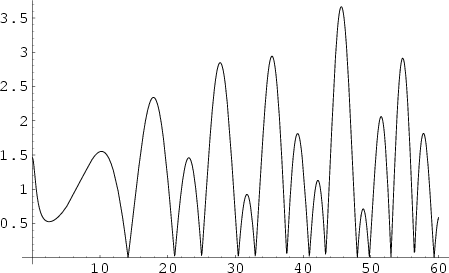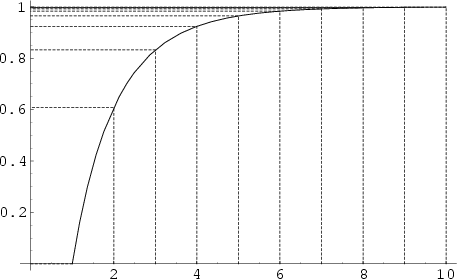 Riemann Zeta Function
Riemann Zeta Function
Abramowitz, M. and Stegun, C. A. (Eds.). ``Riemann Zeta Function and Other Sums of Reciprocal Powers.''
§23.2 in Handbook of Mathematical Functions with Formulas, Graphs, and Mathematical Tables, 9th printing.
New York: Dover, pp. 807-808, 1972.
Apéry, R. ``Irrationalité de  et
et  .'' Astérisque 61, 11-13, 1979.
.'' Astérisque 61, 11-13, 1979.
Apostol, T. M. ``A Proof that Euler Missed: Evaluating  the Easy Way.'' Math. Intel. 5, 59-60, 1983.
the Easy Way.'' Math. Intel. 5, 59-60, 1983.
Arfken, G. Mathematical Methods for Physicists, 3rd ed. Orlando, FL: Academic Press, pp. 332-335, 1985.
Ayoub, R. ``Euler and the Zeta Function.'' Amer. Math. Monthly 81, 1067-1086, 1974.
Bailey, D. H. ``Multiprecision Translation and Execution of Fortran Programs.'' ACM Trans. Math. Software. To appear.
Bailey, D. and Plouffe, S. ``Recognizing Numerical Constants.''
http://www.cecm.sfu.ca/organics/papers/bailey/.
Berndt, B. C. Ch. 14 in Ramanujan's Notebooks, Part II. New York: Springer-Verlag, 1988.
Borwein, D. and Borwein, J. ``On an Intriguing Integral and Some Series Related to  .''
Proc. Amer. Math. Soc. 123, 1191-1198, 1995.
.''
Proc. Amer. Math. Soc. 123, 1191-1198, 1995.
Brent, R. P.; van der Lune, J.; te Riele, H. J. J.; and Winter, D. T. ``On the Zeros of the Riemann
Zeta Function in the Critical Strip. I.'' Math. Comput. 33, 1361-1372, 1979.
Castellanos, D. ``The Ubiquitous Pi. Part I.'' Math. Mag. 61, 67-98, 1988.
Choe, B. R. ``An Elementary Proof of
 .'' Amer. Math. Monthly
94, 662-663, 1987.
.'' Amer. Math. Monthly
94, 662-663, 1987.
Davenport, H. Multiplicative Number Theory, 2nd ed. New York: Springer-Verlag, 1980.
Edwards, H. M. Riemann's Zeta Function. New York: Academic Press, 1974.
Farmer, D. W. ``Counting Distinct Zeros of the Riemann Zeta-Function.'' Electronic J. Combinatorics 2, R1 1-5, 1995.
http://www.combinatorics.org/Volume_2/volume2.html#R1.
Giesy, D. P. ``Still Another Proof that
 .'' Math. Mag. 45, 148-149, 1972.
.'' Math. Mag. 45, 148-149, 1972.
Guy, R. K. ``Series Associated with the  -Function.'' §F17 in
Unsolved Problems in Number Theory, 2nd ed. New York: Springer-Verlag, pp. 257-258, 1994.
-Function.'' §F17 in
Unsolved Problems in Number Theory, 2nd ed. New York: Springer-Verlag, pp. 257-258, 1994.
Hardy, G. H. and Wright, E. M. An Introduction to the Theory of Numbers, 5th ed.
Oxford, England: Clarendon Press, p. 255, 1979.
Holme, F. ``Ein enkel beregning av
 .'' Nordisk Mat. Tidskr. 18, 91-92 and 120, 1970.
.'' Nordisk Mat. Tidskr. 18, 91-92 and 120, 1970.
Ivic, A. A. The Riemann Zeta-Function. New York: Wiley, 1985.
Ivic, A. A. Lectures on Mean Values of the Riemann Zeta Function. Berlin: Springer-Verlag, 1991.
Karatsuba, A. A. and Voronin, S. M. The Riemann Zeta-Function. Hawthorne, NY: De Gruyter, 1992.
Katayama, K. ``On Ramanujan's Formula for Values of Riemann Zeta-Function at Positive Odd Integers.'' Acta Math. 22, 149-155, 1973.
Kimble, G. ``Euler's Other Proof.'' Math. Mag. 60, 282, 1987.
Knopp, K. and Schur, I. ``Über die Herleitug der Gleichung
 .''
Archiv der Mathematik u. Physik 27, 174-176, 1918.
.''
Archiv der Mathematik u. Physik 27, 174-176, 1918.
Kortram, R. A. ``Simple Proofs for
 and
and
 .'' Math. Mag. 69, 122-125, 1996.
.'' Math. Mag. 69, 122-125, 1996.
Le Lionnais, F. Les nombres remarquables. Paris: Hermann, p. 35, 1983.
Lehman, R. S. ``On Liouville's Function.'' Math. Comput. 14, 311-320, 1960.
Matsuoka, Y. ``An Elementary Proof of the Formula
 .''
Amer. Math. Monthly 68, 486-487, 1961.
.''
Amer. Math. Monthly 68, 486-487, 1961.
Papadimitriou, I. ``A Simple Proof of the Formula
 .''
Amer. Math. Monthly 80, 424-425, 1973.
.''
Amer. Math. Monthly 80, 424-425, 1973.
Patterson, S. J. An Introduction to the Theory of the Riemann Zeta-Function.
New York: Cambridge University Press, 1988.
Plouffe, S. ``Identities Inspired from Ramanujan Notebooks.'' http://www.lacim.uqam.ca/plouffe/identities.html.
Simmons, G. F. ``Euler's Formula
 by Double Integration.'' Ch. B. 24 in
Calculus Gems: Brief Lives and Memorable Mathematics. New York: McGraw-Hill, 1992.
by Double Integration.'' Ch. B. 24 in
Calculus Gems: Brief Lives and Memorable Mathematics. New York: McGraw-Hill, 1992.
Sloane, N. J. A. Sequence
A002432/M4283
in ``An On-Line Version of the Encyclopedia of Integer Sequences.''
http://www.research.att.com/~njas/sequences/eisonline.html and Sloane, N. J. A. and Plouffe, S.
The Encyclopedia of Integer Sequences. San Diego: Academic Press, 1995.
Spanier, J. and Oldham, K. B. ``The Zeta Numbers and Related Functions.''
Ch. 3 in An Atlas of Functions. Washington, DC: Hemisphere, pp. 25-33, 1987.
Stark, E. L. ``Another Proof of the Formula
 .''
Amer. Math. Monthly 76, 552-553, 1969.
.''
Amer. Math. Monthly 76, 552-553, 1969.
Stark, E. L. ``
 .'' Praxis Math. 12, 1-3, 1970.
.'' Praxis Math. 12, 1-3, 1970.
Stark, E. L. ``The Series

 , 3, 4, ..., Once More.'' Math. Mag. 47, 197-202, 1974.
, 3, 4, ..., Once More.'' Math. Mag. 47, 197-202, 1974.
Stieltjes, T. J. Oeuvres Complètes, Vol. 2 (Ed. G. van Dijk.) New York: Springer-Verlag, p. 100, 1993.
Titchmarsh, E. C. The Zeta-Function of Riemann, 2nd ed. Oxford, England: Oxford University Press, 1987.
Titchmarsh, E. C. and Heath-Brown, D. R. The Theory of the Riemann Zeta-Function, 2nd ed.
Oxford, England: Oxford University Press, 1986.
Vardi, I. ``The Riemann Zeta Function.'' Ch. 8 in Computational Recreations in Mathematica.
Reading, MA: Addison-Wesley, pp. 141-174, 1991.
Wagon, S. ``The Evidence: Where Are the Zeros of Zeta of  ?'' Math. Intel. 8, 57-62, 1986.
?'' Math. Intel. 8, 57-62, 1986.
Wagon, S. ``The Riemann Zeta Function.'' §10.6 in Mathematica in Action. New York: W. H. Freeman, pp. 353-362, 1991.
Yaglom, A. M. and Yaglom, I. M. Problem 145 in Challenging Mathematical Problems with Elementary Solutions, Vol. 2.
New York: Dover, 1987.
Zucker, I. J. ``The Summation of Series of Hyperbolic Functions.'' SIAM J. Math. Anal. 10, 192-206, 1979.
Zucker, I. J. ``Some Infinite Series of Exponential and Hyperbolic Functions.'' SIAM J. Math. Anal. 15, 406-413, 1984.











![]() all have Real Part
all have Real Part
![]() , a line called the ``Critical Strip.'' This is known to be true for the first
, a line called the ``Critical Strip.'' This is known to be true for the first ![]() roots (Brent et al. 1982). The above plot shows
roots (Brent et al. 1982). The above plot shows
![]() for
for ![]() between 0 and 60. As can be seen, the first few
nontrivial zeros occur at
between 0 and 60. As can be seen, the first few
nontrivial zeros occur at ![]() , 21.022040, 25.010858, 30.424876, 32.935062, 37.586178, ... (Wagon 1991,
pp. 361-362 and 367-368).
, 21.022040, 25.010858, 30.424876, 32.935062, 37.586178, ... (Wagon 1991,
pp. 361-362 and 367-368).

![]() and Dirichlet Eta Function
and Dirichlet Eta Function
![]() by
by


![]() known as the Hurwitz Zeta Function can also be defined such that
known as the Hurwitz Zeta Function can also be defined such that
![]() using either Contour Integration or Parseval's Theorem with the appropriate Fourier Series. An interesting formula involving the
product of Primes was first discovered by Euler
using either Contour Integration or Parseval's Theorem with the appropriate Fourier Series. An interesting formula involving the
product of Primes was first discovered by Euler ![]() in 1737,
in 1737,



![\begin{displaymath}
\zeta(x) = \left[{\,\prod_{p=2}^\infty (1-p^{-x})}\right]^{-1},
\end{displaymath}](r_1605.gif)

![]() are
are
![\begin{displaymath}
\sum_{n=2}^\infty [\zeta (n)-1] = 1
\end{displaymath}](r_1608.gif)
![\begin{displaymath}
\sum_{n=2}^\infty (-1)^n[\zeta (n)-1] = {\textstyle{1\over 2}}.
\end{displaymath}](r_1609.gif)




![]() , but can be analytically continued to
, but can be analytically continued to ![]() as follows:
as follows:



![]() ,
,
![\begin{displaymath}
\zeta(2k+1) =({\textstyle{1\over 2}}\pi)^{2k+1}\lim_{t\to\in...
...1}^\infty \left[{\cot\left({i\over 2t+1}\right)}\right]^{2k+1}
\end{displaymath}](r_1633.gif)

![]() with Odd
with Odd ![]() . Let
. Let


![]() is the asymptotic density of
is the asymptotic density of ![]() th-powerfree numbers (i.e.,
Squarefree numbers, Cubefree numbers, etc.). The following table gives the number
th-powerfree numbers (i.e.,
Squarefree numbers, Cubefree numbers, etc.). The following table gives the number ![]() of
of ![]() th-powerfree
numbers
th-powerfree
numbers ![]() for several values of
for several values of ![]() .
.
![]() can be found using a number of different techniques (Apostol 1983, Choe 1987, Giesy 1972, Holme 1970,
Kimble 1987, Knopp and Schur 1918, Kortram 1996, Matsuoka 1961, Papadimitriou 1973, Simmons 1992, Stark 1969, Stark 1970,
Yaglom and Yaglom 1987). The problem of finding this value analytically is sometimes known as the Basler Problem
(Castellanos 1988). Yaglom and Yaglom (1987), Holme (1970), and Papadimitrou (1973) all derive the result from de
Moivre's Identity or related identities.
can be found using a number of different techniques (Apostol 1983, Choe 1987, Giesy 1972, Holme 1970,
Kimble 1987, Knopp and Schur 1918, Kortram 1996, Matsuoka 1961, Papadimitriou 1973, Simmons 1992, Stark 1969, Stark 1970,
Yaglom and Yaglom 1987). The problem of finding this value analytically is sometimes known as the Basler Problem
(Castellanos 1988). Yaglom and Yaglom (1987), Holme (1970), and Papadimitrou (1973) all derive the result from de
Moivre's Identity or related identities.
![]()


![$\displaystyle {2\over \pi} \left[{x^{2n+1}\over 2n+1}\right]^\pi_0 = {2\pi^{2n}\over 2n+1}$](r_1691.gif)





![$\displaystyle +\left.{\cos(mx)\sum_{k=1}^n {(-1)^{k+1}\over (2k-3)!m^{2n-2k+2}} x^{2k-1}}\right]_0^\pi.$](r_1700.gif)







![]() can also be found simply using the Root Linear Coefficient Theorem. Consider the equation
can also be found simply using the Root Linear Coefficient Theorem. Consider the equation
![]() and expand sin in a Maclaurin Series
and expand sin in a Maclaurin Series

![$\displaystyle \int_0^1 [(x+{\textstyle{1\over 2}}x^2 y+{\textstyle{1\over 3}} x^3y^2+\ldots)]^1_0\,dy$](r_1723.gif)

![$\displaystyle \left[{y+{y^2\over 2^2}+{y^3\over 3^2}+\ldots}\right]_0^1=1+{1\over 2^2}+{1\over 3^2}+\ldots.$](r_1725.gif)

![$\displaystyle 4\int_0^{\sqrt{2}\,/2} \left[{\int_0^u {dv\over 2-u^2+v^2}}\right]\,du$](r_1737.gif)
![$\displaystyle 4\int_0^{\sqrt{2}\,/2} \left[{{1\over\sqrt{2-u^2}} \tan^{-1}\left({v\over \sqrt{2-u^2}}\right)}\right]_0^u\,du$](r_1738.gif)


![$\displaystyle 4\int_{\sqrt{2}\,/2}^{\sqrt{2}} \left[{\int_0^{\sqrt{2}\,-u} {dv\over 2-u^2+v^2}}\right]\,du$](r_1749.gif)
![$\displaystyle 4\int_{\sqrt{2}\,/2}^{\sqrt{2}} \left[{{1\over\sqrt{2-u^2}}\tan^{-1}\left({v\over \sqrt{2-u^2}}\right)}\right]_0^{\sqrt{2}\,-u}
\,du$](r_1750.gif)

![$\quad =\tan^{-1}\left[{\sin({\textstyle{1\over 2}}\pi-\theta)\over 1+\cos({\textstyle{1\over 2}}\pi-\theta)}\right]$](r_1754.gif)
![$\quad = \tan^{-1}\left\{{2\sin[{\textstyle{1\over 2}}({\textstyle{1\over 2}}\pi...
...over 2\cos^2[{\textstyle{1\over 2}}({\textstyle{1\over 2}}\pi-\theta)]}\right\}$](r_1755.gif)

![$\displaystyle 4\left[{\left({{\pi^2\over 8}-{\pi^2\over 16}}\right)-\left({{\pi^2\over 24}-{\pi^2\over 144}}\right)}\right]= {\pi^2\over 9}.$](r_1759.gif)
![]() Riemann Zeta Function
Riemann Zeta Function
![]() et
et ![]() .'' Astérisque 61, 11-13, 1979.
.'' Astérisque 61, 11-13, 1979.
![]() the Easy Way.'' Math. Intel. 5, 59-60, 1983.
the Easy Way.'' Math. Intel. 5, 59-60, 1983.
![]() .''
Proc. Amer. Math. Soc. 123, 1191-1198, 1995.
.''
Proc. Amer. Math. Soc. 123, 1191-1198, 1995.
![]() .'' Amer. Math. Monthly
94, 662-663, 1987.
.'' Amer. Math. Monthly
94, 662-663, 1987.
![]() .'' Math. Mag. 45, 148-149, 1972.
.'' Math. Mag. 45, 148-149, 1972.
![]() -Function.'' §F17 in
Unsolved Problems in Number Theory, 2nd ed. New York: Springer-Verlag, pp. 257-258, 1994.
-Function.'' §F17 in
Unsolved Problems in Number Theory, 2nd ed. New York: Springer-Verlag, pp. 257-258, 1994.
![]() .'' Nordisk Mat. Tidskr. 18, 91-92 and 120, 1970.
.'' Nordisk Mat. Tidskr. 18, 91-92 and 120, 1970.
![]() .''
Archiv der Mathematik u. Physik 27, 174-176, 1918.
.''
Archiv der Mathematik u. Physik 27, 174-176, 1918.
![]() and
and
![]() .'' Math. Mag. 69, 122-125, 1996.
.'' Math. Mag. 69, 122-125, 1996.
![]() .''
Amer. Math. Monthly 68, 486-487, 1961.
.''
Amer. Math. Monthly 68, 486-487, 1961.
![]() .''
Amer. Math. Monthly 80, 424-425, 1973.
.''
Amer. Math. Monthly 80, 424-425, 1973.
![]() by Double Integration.'' Ch. B. 24 in
Calculus Gems: Brief Lives and Memorable Mathematics. New York: McGraw-Hill, 1992.
by Double Integration.'' Ch. B. 24 in
Calculus Gems: Brief Lives and Memorable Mathematics. New York: McGraw-Hill, 1992.
![]() .''
Amer. Math. Monthly 76, 552-553, 1969.
.''
Amer. Math. Monthly 76, 552-553, 1969.
![]() .'' Praxis Math. 12, 1-3, 1970.
.'' Praxis Math. 12, 1-3, 1970.
![]()
![]() , 3, 4, ..., Once More.'' Math. Mag. 47, 197-202, 1974.
, 3, 4, ..., Once More.'' Math. Mag. 47, 197-202, 1974.
![]() ?'' Math. Intel. 8, 57-62, 1986.
?'' Math. Intel. 8, 57-62, 1986.